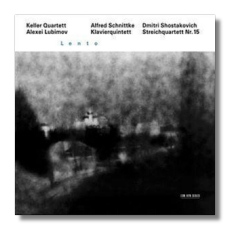
The Internet's Premier Classical Music Source
Related Links
- Latest Reviews
- More Reviews
-
By Composer
-
Collections
DVD & Blu-ray
Books
Concert Reviews
Articles/Interviews
Software
Audio
Search Amazon
Recommended Links
Site News
 CD Review
CD Review
Lento

- Alfred Schnittke: Piano Quintet
- Dmitri Shostakovich: String Quartet #15
Keller Quartet
Alexei Lubimov, piano
ECM New Series 1755 (461815-2) DDD 65:02
These works actively propound the belief that the unexamined death is not worth dying. Alfred Schnittke's Piano Quintet was begun in 1972, following his mother's death from a stroke. (The composer himself was eventually killed in 1998 by the last in a series of strokes.) Dmitri Shostakovich's fifteenth and final string quartet was premièred in November 1974, just a few months before his death. He was ailing as he wrote it, and he had difficulty mustering the physical strength required to put pen to paper. Completing this last quartet was an act of willpower for the seriously ill composer.
Both composers knew what it was like to live and work under the totalitarian rule of the Soviet Union. Such oppression affected their health – both physical and psychological. It also must have affected their views on life and death. For those denied freedom – whether through physical paralysis or political paranoia – death is a member of the family, and dying is like a slow dance at a family reunion. Those who have lived their lives relatively free from oppression tend to be more surprised at the arrival of death. For them, he is an unwelcome stranger – an unwanted door-to-door salesman, if you will – and not a familiar face.
Steeped in morbidity and predominantly slow (indeed, the Shostakovich is a chain of six slow movements), these two works have much in common, at least on the surface. Still, they are more different than similar. Schnittke's Piano Quintet has many moments of mockery and grotesque humor. For example, the second movement is contaminated by a waltz that never gets off the ground; the pieces are there, but they can't assemble themselves into a coherent, directional form. (I think of the end of Bram Stoker's Dracula where the vampire's fangs – all that are left of him – weakly scrabble in the dirt, no longer able to bite anyone.) The final movement sounds like a mother's final lullaby. Overall, Schnittke's Piano Quintet reflects his eclectic style of composition, but with an emphasis on the awfulness of sentiment, the indignity of emotion, and the need to hide one's blackest despair behind jokes and banalities.
Shostakovich certainly was capable of humor, but none can be found in his last string quartet. One striking feature of this work is its allusions – in mood and style, if not in content – to the liturgical music of the Russian Orthodox church. The four strings frequently "chant" in the manner of those impressively deep-voiced choirs of monks. Another striking feature is its spareness. It isn't "minimalistic" in the manner of Philip Glass, but it is radically stripped down, as if the process of committing each note to paper was a painful one. The word "tragic" comes up repeatedly when one reads about this work, but there is more to it than that. While Schnittke used black humor to cope with tragedy in his Piano Quintet, Shostakovich used anger (at the start of the second movement, for example) and retreats into fantasy (in the last movement) to cope with this tragedy. One last thing that both works have in common is, if not a promise of redemption, at least a glimmer of hope, as the final bars are reached. The music comes to an end, but one senses that something of the composer and his work is extending beyond the double bars. Even after death, music goes on.
The Kellers and pianist Lubimov give lacerating performances of these two works. There is no shortage of alternate recordings, but the uncompromising intensity that the present performers bring to this music makes it hard for me to accept anything less. This is not an "easy" CD to listen to. The performers deserve credit for daring to couple these works, and then for having the sensitivity to identify the many shades of gray that lie within them. The cloister-like sonics suit the music.
Copyright © 2003, Raymond Tuttle


















